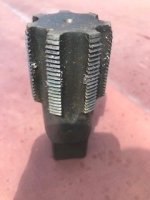oceanobob
Plastic
- Joined
- May 18, 2014
- Location
- Oceano, CA
Dimension the problem? Since a lot of pipe installation is to make almost all the male pipe threads (except for nipples) and purchase the fittings, would like to know if a short involvement with a new HSS pipe tap would improve the subsequent fitment? While gaging may also be the answer, not sure if that will detect the possibility the threads, being mass produced, allow for some extra space - which then challenges the pipe sealant's ability to prevent leaks.
The basic process would be to insert the tap in the fitting and maybe turn it a quarter to a half turn, not so much it alters the fitting greatly but more or less would be analagous to a the nickname 'ghost pass'.
If a small amount of hand tapping would refine the shape and the details of the thread form and this helps to improve the fitment, the process could also be gaged before and after to validate the operation.
Seems that since we make the male threads (up to four inches using sched 40 and sched 80 steel pipe A53 and A106), the focus of the issues/comments is the male thread yet the fitting is somehow never mentioned....thus the musing how would we know if the fitting is the contributor.
The basic process would be to insert the tap in the fitting and maybe turn it a quarter to a half turn, not so much it alters the fitting greatly but more or less would be analagous to a the nickname 'ghost pass'.
If a small amount of hand tapping would refine the shape and the details of the thread form and this helps to improve the fitment, the process could also be gaged before and after to validate the operation.
Seems that since we make the male threads (up to four inches using sched 40 and sched 80 steel pipe A53 and A106), the focus of the issues/comments is the male thread yet the fitting is somehow never mentioned....thus the musing how would we know if the fitting is the contributor.




